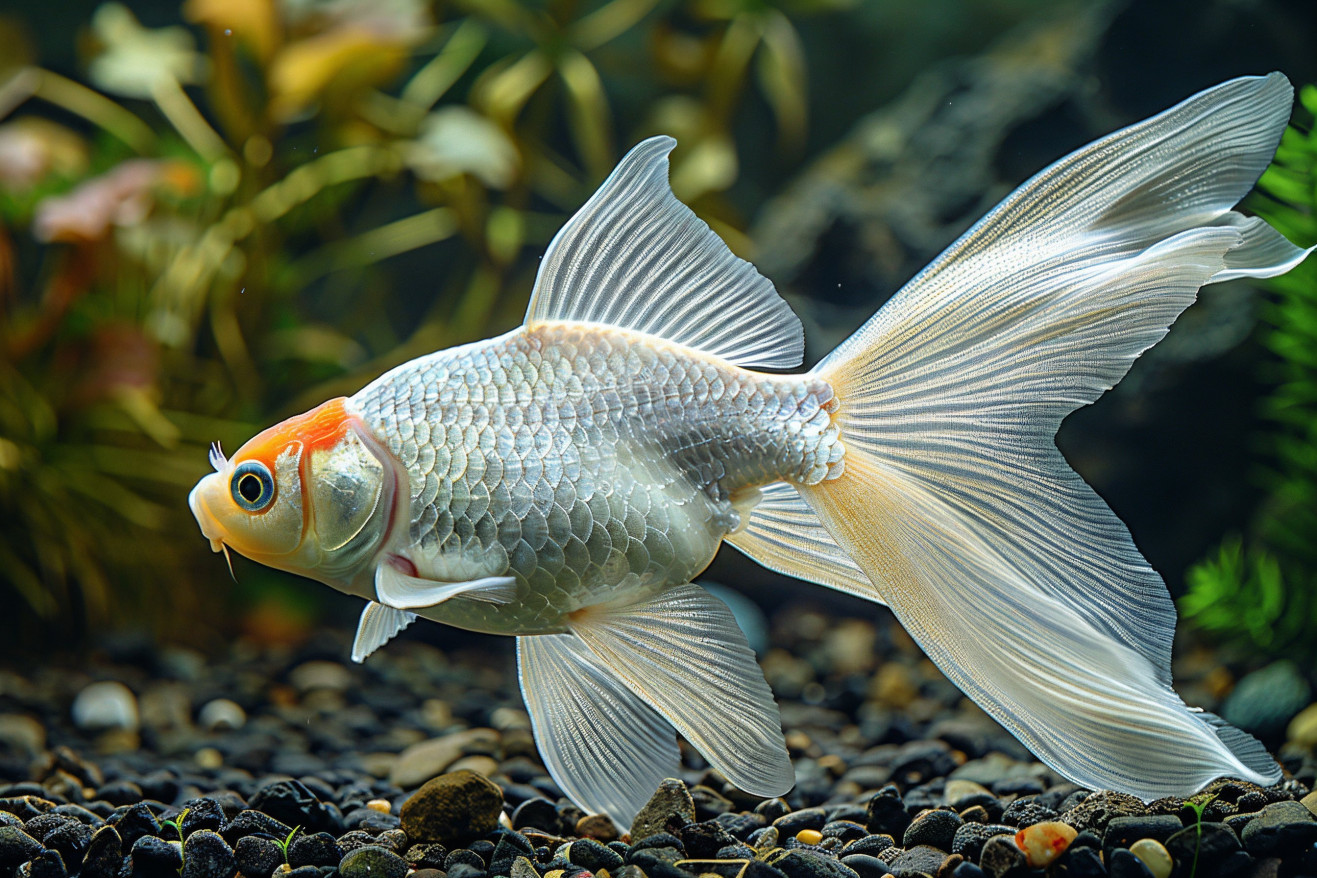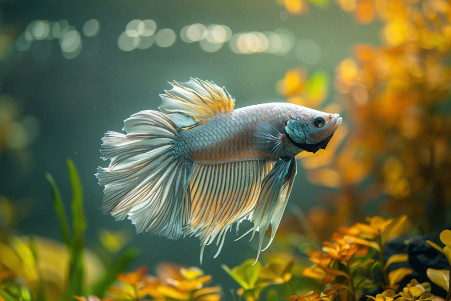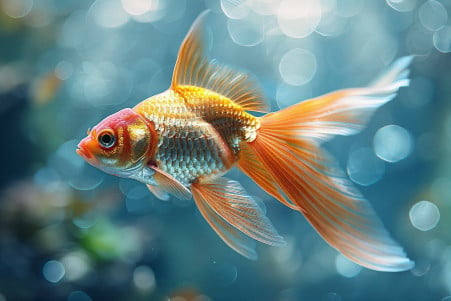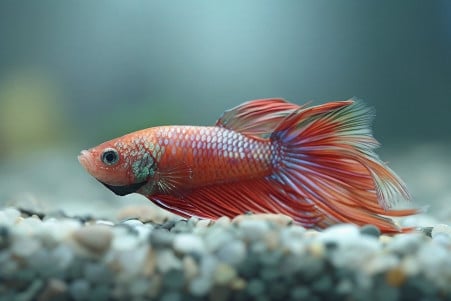Why Is My Goldfish Turning White? Exploring the Causes
9 June 2024 • Updated 8 June 2024

If you've ever had a goldfish that suddenly started to change from a bright, beautiful color to white, you may have wondered why. There are a number of reasons why this might happen, and they can range from environmental factors to genetic conditions. Some of the most common reasons your goldfish is turning white include pigment loss due to poor water quality, low-quality food, stress, and old age. There's also a genetic mutation called "Pearl" that causes goldfish to lose their dark pigment cells. In some cases, pigment loss can be reversed by improving water quality and diet.
In this evidence-based review of why goldfish turn white, we'll explore the findings of researchers in the fields of aquaculture, fish genetics, and veterinary medicine. By the end of this article, you'll have a better understanding of the potential causes of this color change and any potential solutions or preventative measures you can take to keep your fish looking their best.
Why is my goldfish turning white?
What Is White Spot Disease (Ich) in Goldfish?
White spot disease, or ich, or Ichthyophthirius multifiliis, is a highly contagious and potentially deadly parasitic infection that commonly affects goldfish. The white spots that give the disease its name are the result of the fish's immune system's reaction to the parasite, which burrows into the fish's skin and gills. In addition to the white spots, The Spruce Pets notes that symptoms of ich include lethargy, clamped fins, rapid gill movement, and flashing (rubbing against objects).
Ich is often brought on by stressors like sudden temperature drops or poor water quality, which can weaken the fish's immune system and make it easier for the parasite to take hold. The parasite has a 5-stage life cycle that, per Complete Goldfish Care, takes about 4 days to complete at a temperature of 75-79°F (24-26°C).
The treatment target is the free-swimming stage of the parasite. The most effective treatment is a combination of gradually raising the water temperature to the mid-80s (27°C+) using an aquarium heater, which will speed up the life cycle, and salt or chemical treatments such as methylene blue or malachite green to kill the parasites when they're released into the water. It's also important to maintain good water quality during treatment.
Environmental Factors and Proper Goldfish Care
One of the most important factors in preventing goldfish from turning white is maintaining good water quality. The Complete Fancy Goldfish Care Guide from Luke's Goldies explains that it's important to keep an eye on water temperature, pH, ammonia, nitrites, and nitrates, as well as to perform regular water changes. Advanced Aquarium Concepts suggests weekly 50% water changes to keep nitrates under 20ppm.
In addition to water quality, proper filtration, aeration, and tank size are important for keeping goldfish healthy and preventing stress-induced color changes. PetMD explains that goldfish need a lot of filtration, and that the filter should be cleaned at least once a month. Air stones are also important for providing the strong aeration that goldfish need for their activity and health.
Feeding goldfish a balanced diet that includes high-quality pellets, vegetables, and the occasional live or frozen food can also help ensure that their colors remain bright, according to the Aqueon Goldfish Care Guide. The guide also explains that the right lighting, decorations, and substrate can also affect goldfish color and health.
By making sure that goldfish are kept in optimal conditions and are fed and cared for properly, owners can help ensure that their fish don't turn white or experience other health problems.
Can White Goldfish Turn Back to Their Original Color?
Depending on the cause of the color change, it may be possible for a white goldfish to return to its original color. According to hygger, if environmental factors are causing the fish to lose its color, improving water quality, ensuring the fish gets enough light, and making sure the fish isn’t lacking any nutrients can help the fish return to its original color.
If the color change is due to stress or illness, PetHelpful says that treating the underlying cause and giving the fish time to heal can sometimes help the fish return to its original color. However, if the fish is older or has a genetic predisposition to the color change, it may not be possible for the fish to return to its original color.
As noted by Ferplast, it’s important to work with a vet or an experienced fish keeper to figure out the best way to address the issue in each individual fish. However, if the fish’s specific issues are addressed, it may be possible for the fish to return to its original color.
Genetic Factors and Selective Breeding for Color Variations
Goldfish have a wide variety of colors due to selective breeding that has taken place over hundreds of years. Evidence for the evolutionary origin of goldfish derived from the distant crossing of red crucian carp × common carp notes that experimental hybrid goldfish have been created by crossing red crucian carp (Carassius auratus) and common carp (Cyprinus carpio) and then performing gynogenesis, which has led to a variety of color patterns.
As explained in FAQs on Goldfish Genetic/Developmental Disease 1, genetic "deformities" and mutations are often purposefully bred into goldfish to create ornamental types with unique characteristics, such as pop-eye or twin-tail goldfish. Goldfish morphology as a model for evolutionary developmental biology describes how these genetic factors can be used to create specific color patterns and body shapes in goldfish through selective breeding.
At the same time, the article explains that some genetic mutations can also cause health problems or swimming difficulties, which means it's important for breeders to be careful in their selection of goldfish to ensure that they are healthy overall.
How to Take Care of White Goldfish
Because white goldfish can be more prone to stress and health issues, it’s especially important to keep an eye on water quality and ensure that the tank’s water is always at the right levels. This will help ensure that your fish doesn’t get sick.
In addition to this, you should make sure that you’re feeding your fish a healthy and varied diet. This will help ensure that your fish is getting all of the nutrients that it needs to be healthy and happy. In some cases, this can even help restore your fish’s color.
Finally, make sure that you’re keeping an eye on your fish. This way, you can make sure that you catch any health issues early on, which will make them easier to treat. This is especially important for white goldfish, as they can be more prone to health issues.
In addition to this, make sure that you’re keeping an eye on your fish’s color. If you notice that your fish is losing its color, you may want to consider changing the lighting and background colors in your tank. This can help ensure that your fish’s color is restored.
Conclusion: How to Keep Your Goldfish Healthy and Colorful
Knowing the many reasons why goldfish turn white is important for good pet care and the health of these beloved aquarium fish. Environmental factors, diet, and water quality are all important in preventing and sometimes even reversing white coloration.
Meanwhile, for genetic or age-related causes, it's important to know how to care for your fish and to understand that color changes are a normal part of a goldfish's life. Regular observation, working with a vet, and responsible breeding can all help make sure that goldfish stay healthy and colorful. By staying ahead of potential causes of whitening and knowing what to look for, goldfish owners can make sure that their fish are healthy, happy, and vibrant.


